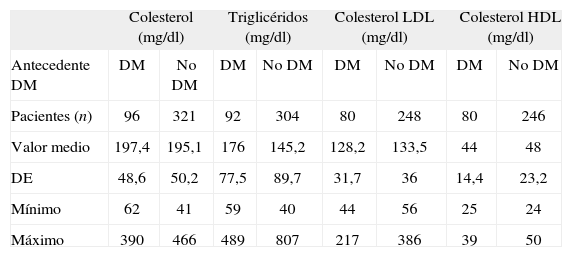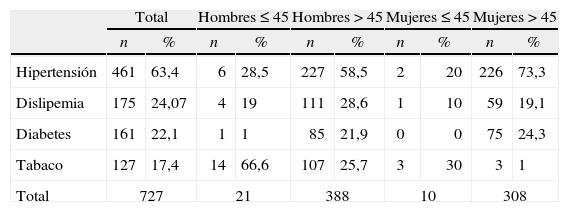El objetivo del estudio era describir los factores de riesgo cardiovascular (FRCV) asociados al ictus, y su detección y control durante el episodio agudo, así como las recomendaciones al alta hospitalaria. La hipótesis era comprobar si la atención integral del internista mejoraba el cuidado de estos pacientes.
Material y métodoSe revisaron historias clínicas de pacientes que habían padecido un ictus entre enero de 2002 y diciembre de 2003, recogiendo diferentes variables biológicas y clínicas.
ResultadosObtuvimos un total de 727 pacientes con enfermedad vascular cerebral (EVC).De éstos, 194 (26,7%) pacientes fueron dados de alta desde el Servicio de Urgencias, y 533 necesitaron hospitalización. La etiología más frecuente fue la isquémica aterotrombótica, excepto en los pacientes menores de 45 años, que fue la indeterminada. El FRCV más prevalente fue la hipertensión arterial.
ConclusionesLa actuación sobre los FRCV durante el ingreso y en el momento del alta fue deficiente. Son necesarios programas de prevención secundaria de los FRCV en el ictus para mejorar la asistencia y la calidad de vida, y disminuir el riesgo de recidiva.
This study has aimed to describe cardiovascular risk factors (CVRF) associated to stroke and their detection and monitoring during the acute episode and the recommendations on hospital discharge. The hypothesis was to check if the integral care of the internist improved the care to these patients.
Material and methodsThe clinical histories of patients who had suffered a stock between January 2002 and December 2003 were reviewed, obtaining different biological and clinical variables.
ResultsWe obtained a total of 727 patients suffering cerebral vascular disease (CVD). Of these, 194 (26.7%) patients were discharged from the Emergency Department and 533 required hospitalization. The most frequent etiology was atherothrombotic ischemia, except in patients under 45 years in which it was the undetermined. The most prevalent CVRF was arterial hypertension.
ConclusionsAction on the CVRFs during admission and at the time of discharge was deficient. Secondary prevention programs of CVRF in stroke are required to improve care, quality of life and decrease relapse risk.
Artículo
Diríjase desde aquí a la web de la >>>FESEMI<<< e inicie sesión mediante el formulario que se encuentra en la barra superior, pulsando sobre el candado.

Una vez autentificado, en la misma web de FESEMI, en el menú superior, elija la opción deseada.

>>>FESEMI<<<












